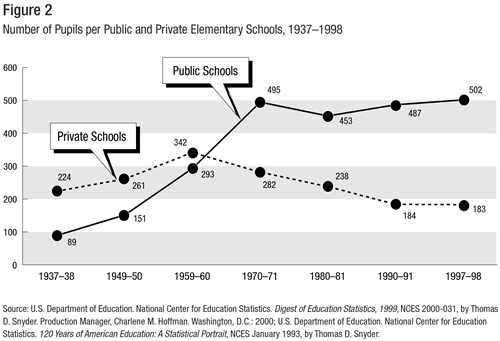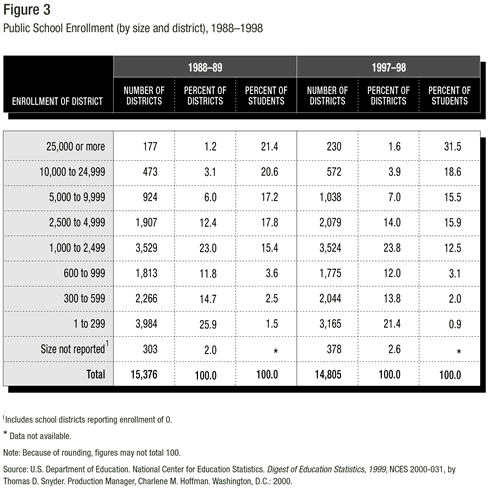Over the past several decades, the public education system has become much more consolidated. If students were strictly economic goods, then the economies of scale associated with consolidation would make perfect sense: more produced, lower costs, and, to some degree, better quality. Students, however, are not just products to be efficiently managed, and the goal of education is not simply to push students through an assembly line–like process and check them off a list. Students are the future of America, and how they are educated is important.
The trend toward consolidation in the public school system has manifested itself in many ways. Since the early part of the twentieth century, the number of public school districts and the number of schools have decreased dramatically (see figure 1). In the 1939–40 school year there were 117,108 school districts; in the 1997–98 school year, just 14,805. Within nearly the same time period, the number of public elementary and secondary schools decreased from 247,127 to 90,661. Although enrollment fluctuated, mirroring demographic trends, overall school enrollment nearly doubled during the same time period while the number of schools was cut by two-thirds. The result is that the average public school size and the average school district size have gradually increased (see figure 2). In the 1937–38 school year, for example, the average enrollment in a public elementary school was 89 students. In the 1997–98 school year, the average enrollment was 502 students.
Arguments for consolidation are based on increased efficiency and economies of scale; however, one consequence has been an increasing separation—distancing parents from those who administer their children’s education. Surveys from the state of Connecticut provide clear examples of the relationship between school consolidation and parental involvement. Between 1988 and 1992, schools that were consolidated (or otherwise grew in enrollment as a result of reorganization) experienced a decrease in parental interaction as evidenced by the following statistics. Over the same comparison period, parents were
• Twelve percent less likely to respond to questionnaires from the school
• Seven percent less likely to say that their school "communicate[d] well" with them
• Ten percent less likely to participate in parent-teacher organizations
• Ten percent less likely to attend a school open house
• Five percent less likely to check their children’s homework
If parents—the third leg of the education stool, which includes students, teachers, and parents—are distancing themselves from the process, a breakdown is inevitable.
In just the last 10 years, the percentage of students concentrated indistricts with 25,000 students or more has increased dramatically (see figure 3). In the 1988–89 school year, 177 school districts (1.2 percent of districts nationwide) had 25,000 or more students enrolled in their district; these 177 districts accounted for 21.4 percent of total enrollment nationwide. Contrast this with the 1997–98 school year, when 230 school districts (1.6 percent of districts nationwide) had 25,000 or more students enrolled in their district—31.5 percent of total enrollment nationwide! Increasingly, parents, teachers, and students are becoming faces in a crowd.
The move toward a more consolidated public school system and fewer, but larger, schools is in stark contrast to private school trends. The number of private elementary and secondary schools has steadily increased: in the 1929–30 school year there were 12,533 private schools; in the 1997–98 school year there were 35,694, nearly three times as many. The number of public schools has steadily decreased: in the 1929–30 school year there were 262,266 schools; in the 1997–98 school year there were 90,661, about one-third as many. In the 1929–30 school year, there were 20 public schools for every private school; by 1997–98, this ratio had fallen to two and a half to one.
|
As our schools and school districts become ever larger, parents, teachers, and students are increasingly becoming mere faces in a crowd. |
Evidence points to the family as a crucial determinant of a student’s achievement. In a recent in-depth study on school performance by Caroline Hoxby, a Harvard professor and Hoover Institution Koret Task Force member, family effects accounted for 34 to 105 times as much variation on achievement as school inputs. As the public education system has become more consolidated, the administration and bureaucracy have grown, distancing parents from educational decisions and input. Consolidation may be economically viable but at a high cost to America’s future—America’s children.










